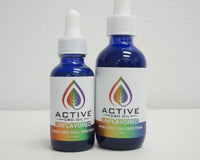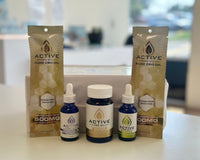One of the main questions customers ask every day is: “What do I do if CBD doesn't work for me?"
The answer is always that everyone is different, and it is impossible to predict what dosage or route of administration will work best for one individual. Customers generally start with low doses of CBD and gradually increase their dosage incrementally to determine their own most effective amount. Some customers benefit from a combination of CBD with other cannabinoids rather than just CBD alone.
In this article, we go over the three steps that people should try if CBD is not working for them.
Step 1: Analyze how much CBD you are taking. You may be taking too much or too little CBD.
Step 2: How are you taking your CBD? The methods of consumption matters for most people. Some people find better results using a tincture (drops under the tongue) rather than a gummy that needs to be digested before it can be absorbed.
Step 3: Are you taking CBD alone or a combination of cannabinoids? When you take CBD with trace amounts of other cannabinoids. It works better in the body. This is called the entourage effect.
But, why do people not just start with a larger amount considering CBD’s limited side effects and safety profile? That is because larger doses of CBD often work less effectively than smaller doses of CBD. If you aren't seeing the benefits you are looking for, analyze the amount of CBD you are taking. For many people - even in high amounts of pain - starting with only 5mg or 10mg is better than starting with 50mg.
With most molecules ingested into the body, such as alcohol, common sense says more of a substance means more of an effect. We are prevented from consuming huge amounts of most chemicals due to toxic effects (nausea, vomiting, “spins”, blackouts, liver damage, and death in the case of alcohol). However, these significant toxic reactions do not occur with CBD - so why not start with 50 mg, when many people find 25 mg effective?
The answer is cannabinoids have unusual dose to effect relationships. These are not generally linear or strictly upward, where more of a cannabinoid would produce a stronger reaction. Instead, CBD works on a bell curve.
Generally the highest level of effectiveness occurs at a peak, and effect diminishes outward in doses higher and lower than the peak. This peak is the individual’s ideal dosage for that specific effect. Using more than the ideal dose will reduce effectiveness, just as a dose that is too small can reduce effectiveness.

Cannabinoids produce varying effects dependent on dose, due to different biological reactions at different doses. Many of the effects produced by CBD are a complex interaction of multiple receptor and enzyme systems. It is not as simple as to say CBD targets one receptor, so more CBD would activate that receptor more strongly. For example, in the endocannabinoid system, at different doses, CBD can either slightly alter the function (allosteric modulation) or block (antagonism) the CB1 receptor (the receptor THC activates to produce intoxication). At the same time, CBD inhibits FAAH and FABP - preventing the breakdown and transport of AEA, an endocannabinoid that acts to mildly activate (partial agonism) the CB1 receptor. Therefore, at just one receptor with only two receptor ligands, different interactions occur depending on dose. This is only one tiny fraction of the endocannabinoid system.
Then consider that the majority of CBD’s biological modifications actually occur outside the endocannabinoid system, involving at a minimum 65 different signaling interactions including the targets below, and the complexity of the interactions producing cannabidiol’s effects begins to be understood.
https://www.ncbi.nlm.nih.gov/pmc/articles/PMC4604182/

As a specific example, the bell shaped curve occurs in data describing CBD’s effects on anxiety in humans during a public speaking anxiety experiment.
https://www.frontiersin.org/articles/10.3389/fphar.2017.00259/full
In rodents, at lower doses, CBD alters the activity of the 5HT1A serotonin receptor, producing an anxiolytic (anti-anxiety) effect. However, at higher doses, CBD is thought to begin activating a receptor known as TRPV1. TRPV1 is responsible for sending signals of temperature and pain in the peripheral nervous system, but in a certain area of the brain this receptor stimulates glutamate firing, the main excitatory neurotransmitter in the brain. As CBD activates TRPV1, increasing the release of glutamate - this begins to excite areas of the brain responsible for feeling anxiety. Eventually the calming activity of the serotonergic modulation is overwhelmed by the anxiogenic (anxiety-causing) glutamate signalling, and the anti-anxiety effect gradually decreases as the dose increases.
https://www.ncbi.nlm.nih.gov/pubmed/19735690
CBD’s modulation of the 5HT1A serotonin receptor also influence the bell-shaped dose response curves seen in data for CBD’s effects on a rodent model of depression. In the image below, it can be seen that all but the one appropriate CBD dose had no significant effect. However, the correct dosage (30 mg/kg) had an antidepressant effect in a rodent model of depression equal to a commonly prescribed antidepressant, imipramine (black bar).

So far, the discussion has focused on bell shaped curves, which need to be distinguished from biphasic dose response curves. Bell shaped curves begin and end at the same level of effect. Biphasic curves would be similar to bell shaped except that the effects go from one effect to the opposite effect. With CBD for most people (although exceptions certainly exist), a large dose of CBD will not begin to cause more anxiety than a person normally feels without any CBD in their system - an effect profile that would be shown by a bell shaped curve. However, consider the effects of THC on anxiety. At very low doses, THC can have a calming, anxiolytic effect. However, use slightly too much THC, and the effect transitions from relieving anxiety to producing overwhelming, completely consuming anxiety. Often, large doses of THC elicit panic reactions, which is the direct opposite of THC’s calming effects at low doses. This would be a biphasic dose-response curve.
https://www.ncbi.nlm.nih.gov/pubmed/17692344



























